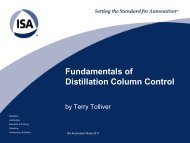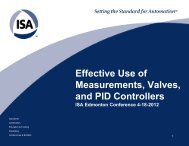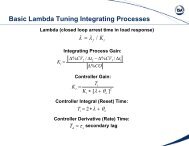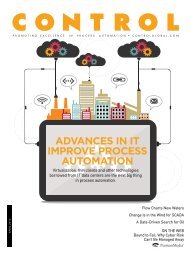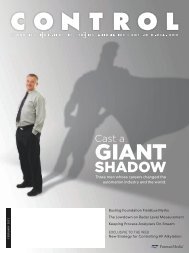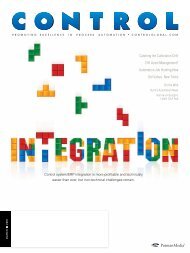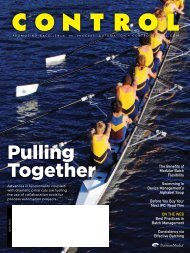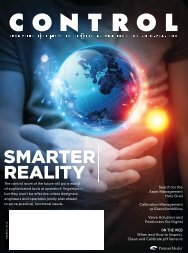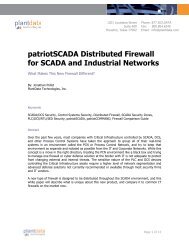April 2011 - Control Global
April 2011 - Control Global
April 2011 - Control Global
Create successful ePaper yourself
Turn your PDF publications into a flip-book with our unique Google optimized e-Paper software.
a s k t h e e x p e r t S<br />
Measurement of Drift, Stability, Offset, Bias.<br />
“Ask the Experts” is moderated by Béla Lipták, process control consultant and editor of the Instrument Engineer’s Handbook<br />
(IEH). He is now recruiting new contributors for the 5th edition. If you are qualified to contribute to this volume, or if you are<br />
qualified to answer questions in this column or want to ask a question, write to liptakbela@aol.com.<br />
QIn determining some of the static and dynamic characteristics<br />
of sensors and other instruments, I find the<br />
definitions of the following terms somewhat confusing.<br />
I find it difficult to differentiate between them. For example.<br />
the ISA dictionary gives the definitions for drift and<br />
stability as follows:<br />
Drift:<br />
ANSI/ISA-S51.1-1979 (R1993). [ISARP67.04.01-2000.ISA-<br />
RP67.04.02-2000]. — An undesired change in output over a<br />
period of time, where the change is unrelated to the input,<br />
environment or load.<br />
[ANSI/ISA-75.05.01-2000] 3. — An undesired change in<br />
the output/input relationship over time.<br />
[ISA-37.1-1975 (1992)] — An undesired change in output<br />
over time that is not a function of the measurand. Drift is<br />
usually expressed as the change in output over a specified<br />
time with fixed input and operation conditions. It is usually<br />
used in the context of analog transducers, analyzers, etc.<br />
Repeatability<br />
Random error<br />
(Precision)<br />
Systematic error<br />
(Bias)<br />
Stability:<br />
[ISA-37.1-1975 (R1982)] — The ability of a transducer to<br />
retain its performance characteristics for a relatively long period<br />
of time. Unless otherwise stated, stability is the ability of<br />
a transducer to reproduce output readings obtained during its<br />
original calibration, at room conditions, for a specified period<br />
of time. It is then typically expressed as being “within X percent<br />
of full scale output for a period of Y months.<br />
[SA-RP55.1-1975(R1983)]— In data processing, a measure of<br />
the ability of a device to maintain constant volumes for one or<br />
more parameters that describe its operation. Freedom from undesirable<br />
deviation. A measure of the controllability of a process.<br />
In our work, these two terms are used quite interchangeably.<br />
When we are calibrating an instrument, and it has an<br />
offset, we say it has drifted. Similarly most test equipment,<br />
such as dry bath calibrators, has stability (both long-term and<br />
short-term) in its specifications. As an aside, stability is also<br />
used to define a process controller that brings the process to<br />
new setpoint after a disturbance. But, at that time, we know<br />
that we are dealing with a process.<br />
I would like to know how we differentiate between these<br />
two characteristics? How do we measure them separately<br />
when evaluating a sensor or another instrument? Similarly,<br />
in order to correctly determine and publish offset and bias<br />
of the various instruments, how should we better understand<br />
what they are?<br />
Yusaf Muti<br />
yousaf_ zai_khan81@ yahoo.com<br />
Illegitimate<br />
error<br />
definition of terms<br />
Total error<br />
(Inaccuracy)<br />
Figure 1. Terms describing the error (inaccuracy) of a sensor<br />
AThe first 150 pages of Volume 1 of the Instrument Engineers’<br />
Handbook deals with such general topics. In<br />
this age of advertisements that show attractive people<br />
and places instead of guaranteed and clearly defined performance<br />
data, it is hard to know how good a sensor is. Some<br />
manufacturers do not even test all their sensors, and their<br />
specifications do not even state how the published numbers<br />
have been arrived at.<br />
For this reason, it would be useful if ISA recommended<br />
the testing methods and also recommended that the performance<br />
found be printed on all instrument specifications, no<br />
matter where the device was produced around the world.<br />
For example, ISA could recommend that all drift specifi-<br />
52 www.controlglobal.com A p r i l / 2 0 1 1



